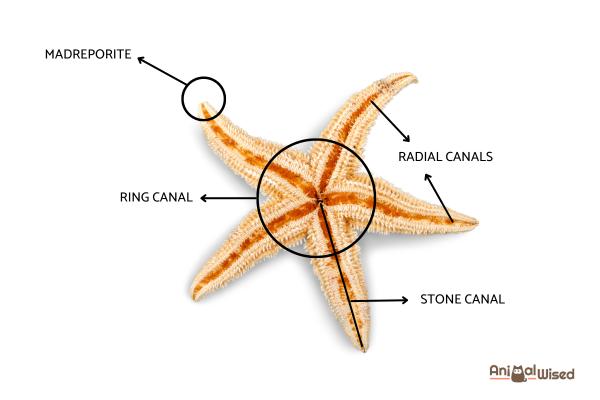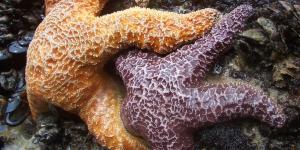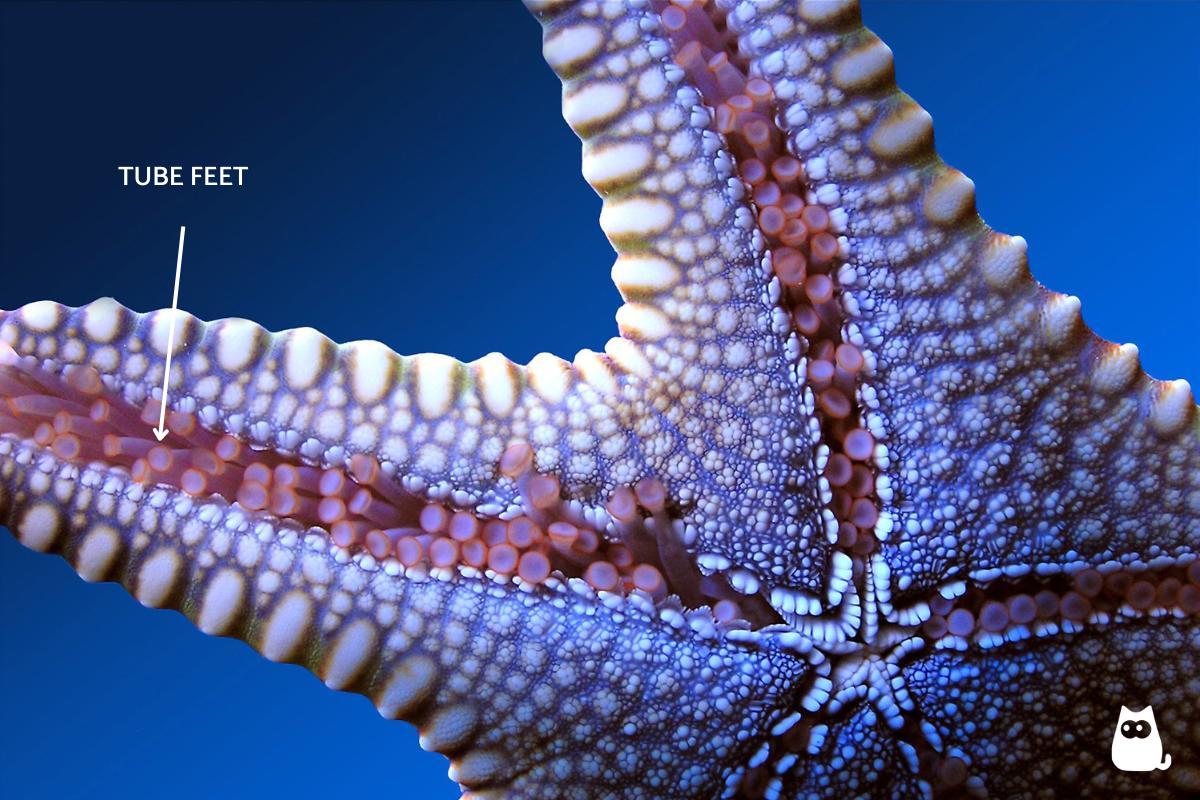How Do Starfish Move?


Starfish, also known as sea stars, inhabit the vast and mysterious ocean depths. Unlike their swimming counterparts, these invertebrates boast a unique star-shaped body with radiating arms. But their most fascinating feature might be their unexpected method of locomotion. Starfish use a unique "crawling" motion that sets them apart from most aquatic animals. Unlike fish that propel themselves with fins, starfish inch across the ocean floor with the help of hundreds of tiny, tube-shaped feet.
In the following AnimalWised article, we will explore the mechanics behind starfish movement, from the intricate structure of their tube feet to the fascinating hydraulic system that powers their crawl.
Anatomy of a starfish
Starfish, also known as sea stars, possess a unique body plan that allows them to thrive in the benthic (seafloor) environment. Let's explore the key components of a starfish's anatomy and their functional roles.
- Central disc: the central disc serves as the central body region, housing vital organs like the stomach, cardiac sac, and reproductive organs. It acts as a central hub from which all other body parts radiate outwards.
- Arms (rays): extending from the central disc are the starfish's characteristic arms, also known as rays. The number of arms varies by species, ranging from five (most common) to over forty. These arms are crucial for movement, feeding, and sensory perception.
- Aboral and oral surfaces: the starfish has a top side (aboral surface), typically rougher and may have spines for protection. The underside (oral surface) houses the mouth and the tube feet.
- Madreporite: located on the aboral surface, near the center of the disc, is a sieve-like structure called the madreporite. This serves as the entry point for seawater into the water vascular system.
- Eye spots (some species): light-sensitive eye spots at the tips of their arms help some starfish species sense light and darkness.
- Skin gills: starfish can also breathe through their skin, covered in tiny bumps called skin gills, which increase the surface area for oxygen diffusion.
It is also important to note that starfish exhibit radial symmetry. This means their body parts are arranged in a spoke-like pattern around a central point (the disc) and they can appear identical when viewed from multiple angles.
Feeling peckish after learning about locomotion? Our recommended article, what do starfish eat, explores the fascinating world of starfish cuisine.
How do starfish move?
Starfish, also known as sea stars, possess a unique method of locomotion distinct from most aquatic animals. Unlike fish that propel themselves through water or creatures that walk on the seabed, starfish utilize a crawling motion.
This crawling movement is achieved through the use of hundreds of tiny, tube-shaped appendages on the underside of their arms. These appendages, known as tube feet, employ what is known as water vascular system.
This intricate network of water-filled canals functions like a series of hydraulic pumps, enabling the starfish to move with surprising efficiency. Here's a breakdown of its components:
- Tube feet: numerous tube-shaped appendages line the underside of each arm. These are the starfish's "feet," and their structure is key to their function. Tube feet are muscular and equipped with tiny suction cups at their tips.
- Madreporite: located on the upper surface of the central disc is a sieve-like structure called the madreporite. This serves as the entry point for seawater into the water vascular system, allowing filtered seawater to enter and fill the canals within.
- Stone canal: the filtered seawater then travels through a short tube called the stone canal. This canal regulates the water pressure within the system.
- Ring canal: from the stone canal, water enters a circular canal encircling the central disc, known as the ring canal. This ring canal acts as a central hub, distributing water to the radial canals in each arm.
- Radial canals: branching off from the ring canal are smaller canals called radial canals, one for each arm. These canals further distribute water to the numerous tube feet along each arm.
The water vascular system functions through muscle contractions that control water flow. When a tube foot needs to extend, water is pumped into it, causing it to expand and stiffen. The suction cups then attach to a surface. Conversely, by relaxing the muscles, water is drawn out, causing the tube foot to contract and detach. This coordinated movement of water and muscle contractions in numerous tube feet allows the starfish to inch across the seabed.
Interestingly, some starfish species exhibit a more rapid form of movement in specific situations. When threatened or searching for food, they can display a bouncing behavior. During this behavior, the starfish strategically fills a number of their tube feet with water in a synchronized manner across their arms. Certain arms extend forward, while the water-filled ones act as pistons, propelling the starfish in a series of bounces. This synchronized movement allows for faster, more efficient travel when necessary.
Beyond the physical suction created by the cup-like structure, some starfish species utilize chemical processes to enhance their grip. Specialized glands at the tip of the tube foot can secrete adhesive substances that further strengthen the attachment to a surface. Conversely, when a tube foot needs to detach, other chemical signals trigger the release of these adhesive secretions, allowing for a smooth release and efficient movement.

Other functions of the water vascular system
The hydraulic system used by starfish is not limited to locomotion. The water vascular system, with its network of canals and pressure-controlled water flow, serves as a true multi-tool for starfish. While locomotion might be its most readily apparent function, these tube feet play a vital role in several other aspects of the starfish's life:
- Anchoring: starfish often live in environments with strong currents. The powerful suction created by the tube feet, combined with the adhesive secretions, allows them to firmly attach themselves to rocks or other stable structures. This anchoring ability helps them resist being swept away by currents and ensures they can efficiently forage for food.
- Capturing food: starfish are opportunistic feeders, and their tube feet play a crucial role in capturing prey. Some starfish species use their tube feet to overpower bivalve mollusks like clams or mussels. The tube feet can pry open the shells or force them apart, allowing the starfish to access the soft tissue inside.
- Respiration: believe it or not, the tube feet also contribute to the starfish's respiratory system. The thin skin of the tube feet allows for gas exchange between the seawater and the internal cavity of the starfish. This process, facilitated by the constant flow of water through the water vascular system, helps the starfish extract oxygen from the surrounding water.
This article delves into the mechanics of their locomotion, revealing the surprising way they use tube feet to travel. Intrigued by the starfish life cycle? Our other article, explores their reproduction process and the journey from egg to adult starfish.

How far do starfish move?
Starfish may not be known for their speed, but they can travel surprisingly varied distances depending on the species and their current needs.
While most starfish move at a leisurely pace, covering mere centimeters per minute, some species can exhibit bursts of faster movement. The sunflower sea star (Pycnopodia helianthoides), for instance, can use a "bouncing" technique to reach speeds of up to one meter per minute.
The distance a starfish travels ultimately depends on its motivations. Short explorations for nearby food sources or escaping a predator might only require them to move a few centimeters. However, their slow speed translates to a limited overall range. Starfish typically stay within a specific area on the seabed, relying on water currents to bring them food or disperse their larvae.
External factors like currents and food availability can also influence travel needs. Some starfish species are known for being relatively sedentary, content to stay put in a specific location for extended periods. Others, depending on their habitat and food sources, may exhibit a more roaming behavior, covering larger distances within their established territory.
This article delves into their secret weapon for movement, but to understand them fully, we need to explore their biology. This other article explores how starfish are classified in the animal kingdom.
If you want to read similar articles to How Do Starfish Move?, we recommend you visit our Facts about the animal kingdom category.
- Encyclopedia Britannica (2024). Study how sieve plates and suction-cupped tube feet enable sea stars to catch prey and move through toilet . Available at: https://www.britannica.com/video/22446/Anatomy-physiology-starfish-tube-feet
- Mulcrone, R. 2005. Asteroidea . Animal Diversity Web. Retrieved May 26, 2024 from https://animaldiversity.org/accounts/Asteroidea/
- Pennisi, E. (2019). Watch this sea star bounce to get around . Available at: https://www.science.org/content/article/watch-sea-star-bounce-get-around







